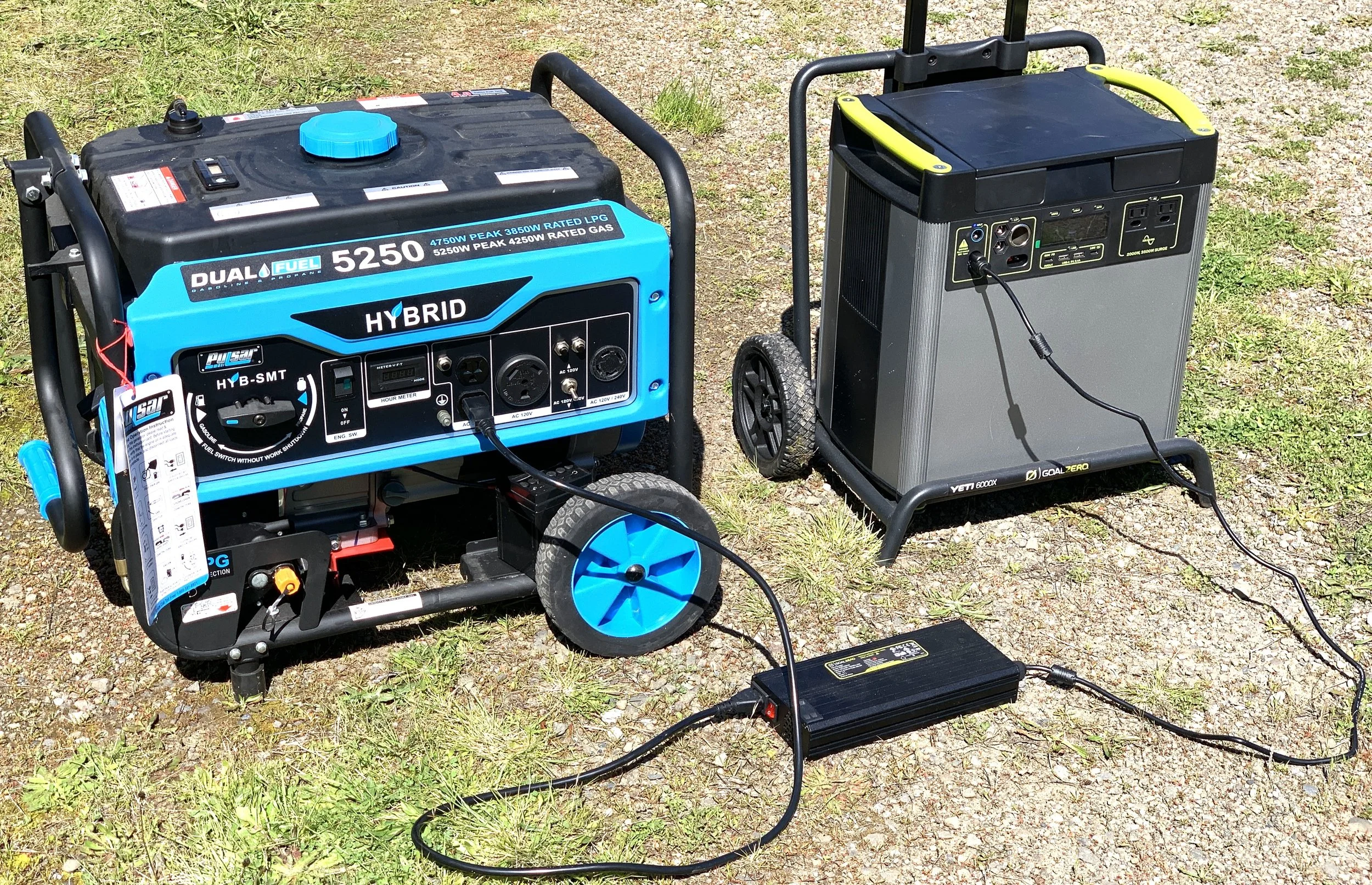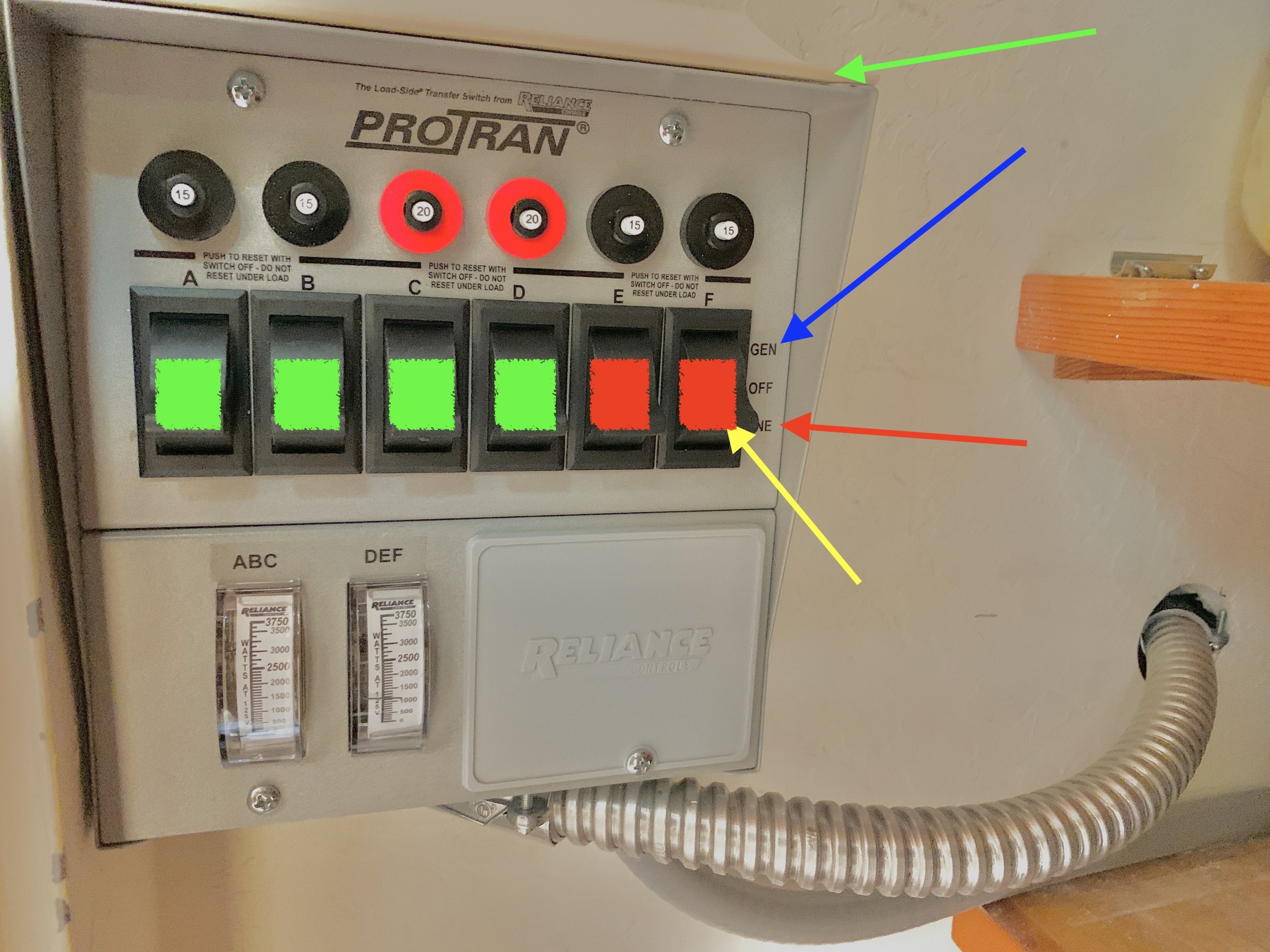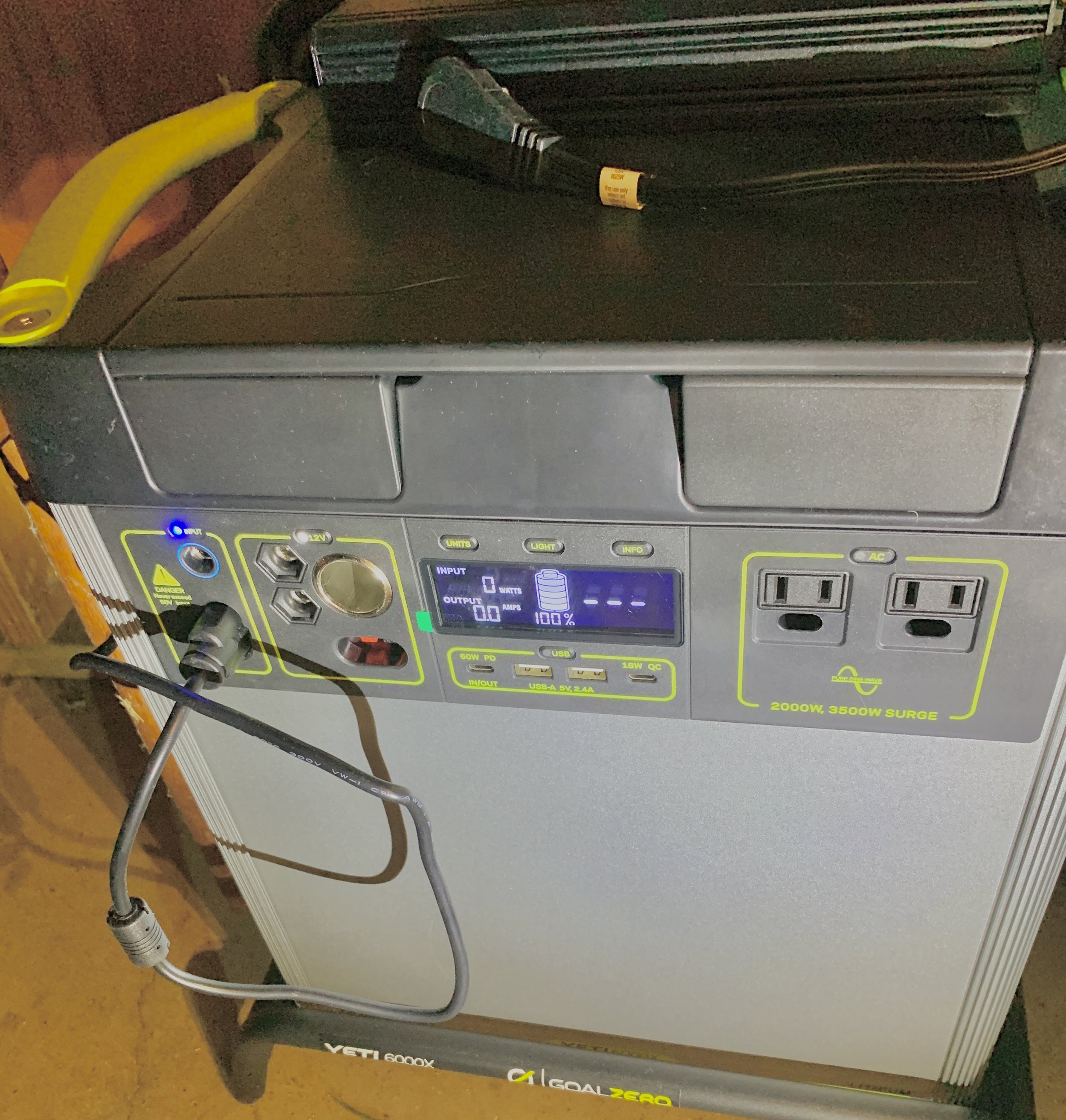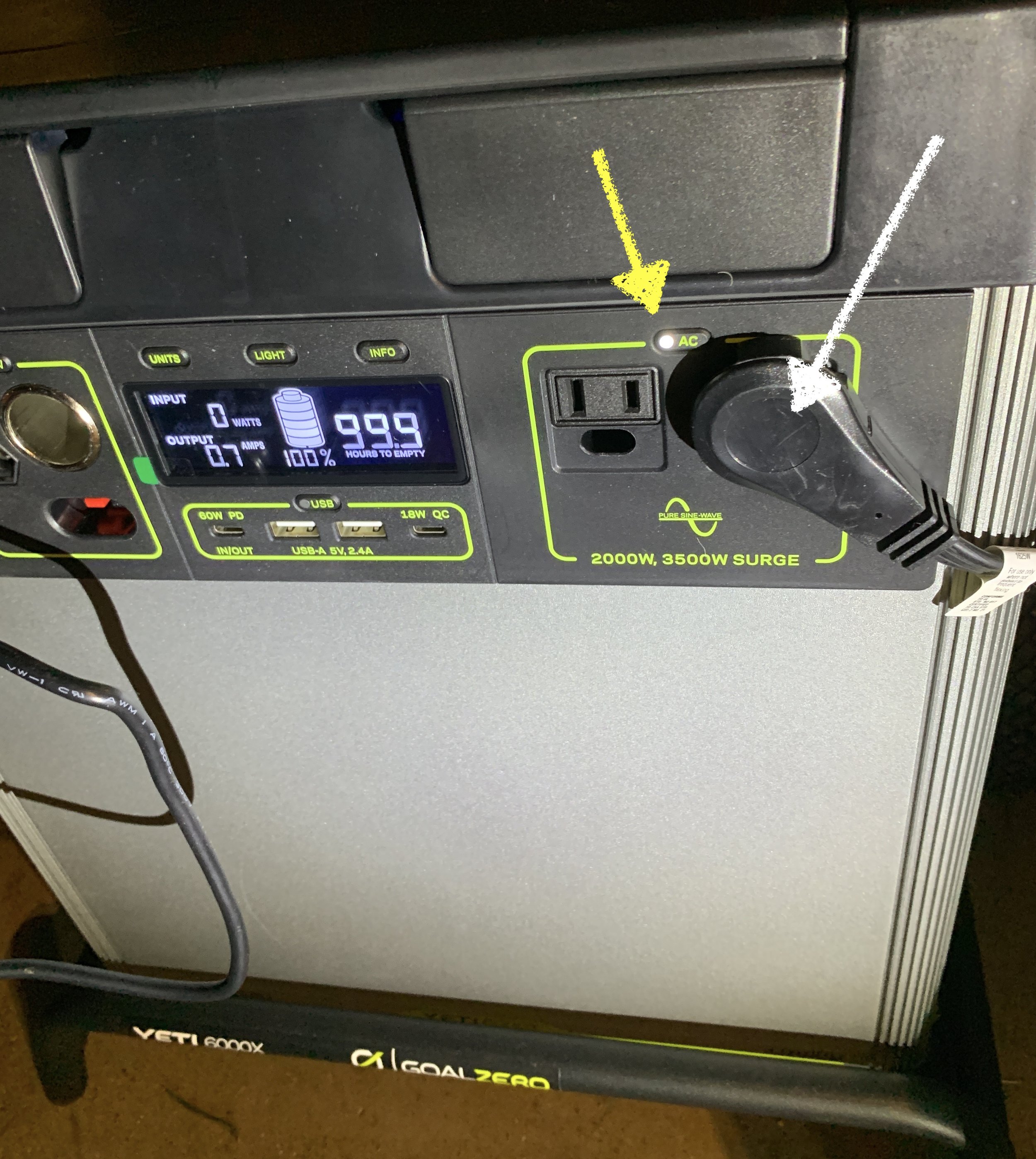FAQ — Bella Vista
RETURN TO BELLA VISTA HOME PAGE
————————————————————-
Power Outages — Use of “Yeti-6000X” Power Back-up System
Photo 1: size comparison of gasoline-operated generator and 6kWh battery (right).
THE SHORT (“default”) VERSION
We have a battery back-up (Photo 1) which will provide energy to
— the Internet system
— the TV/audio/system
— the lamp by the TV and some other outlets in the LR
— the center bathroom and loft, including the internet router
— the garage door opener
— some lights in the garage
for essentially as long as even a multi-day, outage might last.
NOTHING NEEDS TO BE DONE TO ACTIVATE THE BATTERY for this default service. IT’S AUTOMATIC, these circuits are always connected to the battery, independent of power grid.
The Yeti 6000X battery providing this convenience lives in the garage under the work bench (Photo 3). It is automatically being charged via a fairly large power adapter from an outlet strip on the work bench, plugged into the charging input on the lower left of the front panel. In normal operation, a cable is plugged into one of the two 120-V outlets on the right side of the front panel of the Yeti (white arrow in Photo 4). The cable supplies the 120V battery power via a special connector by the front door of the house to the transfer switch located in the small utility room inside the house. A second 120-V outlet on the Yeti can be used for any other desired purpose. Note that the charge power adapter has a small fan inside to dissipate a bit of heat while charging, which creates a humming noise.
THE DETAILED (“custom”) VERSION
If you want electric power delivered to additional circuits during a power outage, such as
— the refrigerator
— some kitchen outlets (so you can use the microwave, water kettle, or toaster, coffee maker), and
— the propane fired space heater and domestic water heater,
then keep on reading.
THE BASICS:
DIFFERENCE BETWEEN “POWER” AND “ENERGY”
— “POWER” is measured in Watts (W); 1000 W = 1 kW
— “ENERGY” is measured in “POWER” x “TIME”
e.g., the POWER of 1000 W used for 1 hour causes 1000 Wh (=1 kWh) ENERGY consumption.
— Our “Yeti” battery has an ENERGY capacity of 6kWh (=6000Wh) and a POWER limit of 1500W.
This means it can deliver a lot of power (up to 1500W), but not an endless ENERGY amount. Just like a flashlight battery, the Yeti’s energy supply does deplete; except it has about 3000 times as much energy as an AAA flashlight battery, and it delivers this energy at regular line voltage (120V-AC) in a perfect sine-wave. You will understand the basics when you appreciate the simple math that our battery can power a 10-Watt demand (such as a typical modern light bulb) for about 600 hrs, or a 100W TV for 60 hrs, or a 1000-Watt water kettle for only 6 hours of operation, or anything logical in-between.
“CONVENTIONAL” POWER OUTAGES:
These are unannounced power interruptions of typically only short duration, perhaps up to a few hours, caused by some sort of external power system failure. Since we are in a rural environment, conventional power outages can be expected to occur a bit more frequently here than in urban locations. If you really need more than the “default” electrical service during a conventional power outage, keep on reading.
PSPS POWER OUTAGES:
The Sea Ranch is serviced by PG&E. As a wildfire prevention measure, PG&E may turn off electric power during extreme weather conditions. Such "Public Safety Power Shutoff" (“PSPS”) situations may last for as long as several days. This has actually happened seldom in the past at Sea Ranch, but nowadays, with global warming, it may happen more frequently. PSPS outages are typically announced beforehand, and we will generally pass the announcement on to our guests.
BRIDGING OVER PSPS OUTAGES:
Photo 2: “Transfer Switches” (the yellow arrow points to one of them) located in the utility closet (left side, at chest level). In normal operation (“LINE,” red arrow), switches B, E, and F are down (i.e., connected to PG&E “line” power. Only switches A, C, and D are up (blue arrow), supplying battery power year round 24/7 to the garage with Internet set-up, the TV set-up in the living room, and to the center bathroom and loft with Internet router. After power outage has started, you may flip — as desired — also switches B, E, and F upward to the “GEN” position (blue arrow).
As described above, our 6000 Wh (6 kWh) “Yeti” back-up battery is always connected to three electrical circuits in the house, which are essential but use little power and energy (Internet & some Garage outlets, and TV/audio system & some BA and LR outlets). Four additional circuits can be added under careful power and energy consumption considerations. This occurs via a transfer switch, which is installed in the utility closet. By flipping switches B, E, and F (see Photo 2) from “normal” operation (“LINE”) over “neutral” to “battery” operation (“GEN”), the power leading to the refrigerator, some kitchen outlets, and the space/water heating system can be diverted to also come from the battery.
You should only flip these switches AFTER HAVING READ THE ENTIRE REST of this page, so to avoid using too much power and running out of energy, and prevent related complications. WE INSTALLED THIS AMENITY FOR OUR PERSONAL USE BUT MAKE IT AVAILABLE TO OUR GUESTS AS A COURTESY. IF YOU MAKE USE OF IT, PLEASE DILIGENTLY FOLLOW THESE INSTRUCTIONS.
Please understand that, even so, not all power outlets and connections will then work, and that lights will still function only in the following places:
— Garage
— Lamp by TV
— Central bathroom
— Kitchen, under the counter, left of microwave
=================================
Photo 3: Yeti 6000X back-up power battery located under work bench in garage. There is also a fairly large, black power adapter on top of the Yeti to charge the Yeti.
CAVEATS WHEN USING BATTERY POWER VIA SWITCHES B, E, and F:
AVOIDING BATTERY OVERLOAD (“POWER” LIMITATIONS):
Typical utility items (microwave, water kettle, toaster, hair dryer) are usually deployed only for short periods of time (perhaps a few minutes), and so they will, in aggregate consume only little battery ENERGY. But they will use a lot of POWER (figure about 1000 Watts each). The Yeti power output is limited to 1500 Watts. Therefore, DO NOT USE ANY TWO OF THESE APPLIANCES AT THE SAME TIME, so not to blow a fuse. (Lights, TV, Internet etc. use very little power and can therefore all be on and running simultaneously).
AVOIDING BATTERY DEPLETION (“ENERGY” LIMITATIONS):
(a) Use microwave, toaster, water kettle, coffee maker, hair dryer mindfully. For example, even though a 2-minute mirowaving event may consume only 30Wh of energy, many of such events will add up to an appreciable energy draw from the battery.
(b) The propane operated space heater uses only little power to drive the fans (about 170 Watts), and you can be warm and cozy for a few hours without significantly draining the battery. Similarly, domestic water (kitchen, bathrooms, showers) is heated with propane and operates with negligible electric energy. (Note that our heat pump, which is the most environmentally friendly method for space heating, draws a lot of electric power AND energy and cannot be supplied by the Yeti).
BASIC UNDERSTANDING
Here are some basic notes providing understanding how long the battery will last, and how to conserve battery energy:
— The Yeti has Li-ion batteries. Just like EVs with Li-ion batteries, one should avoid charging the batteries higher than to 80% of capacity during normal operation. This is automatically done, and only prior to a scheduled PSPS power outage will we electronically (remotely) override this setting and charge all the way up to 100%.
— Treat this back-up power like you would a flashlight. Use only when needed, as it runs out of energy after a while. Whenever you use Yeti energy during the brown-out period, such as for lights or TV, the energy left as reserve will shrink. The front panel of the Yeti shows you how much power you are currently using and how much energy is still left. You start with 5000-6000 Watt-hours at your avail, which can bridge over quite a long power outage if you are frugal.
— The transfer switches disconnect the [six] pre-selected circuits from the big house breaker panel and turn their function over to the Yeti battery. This means, when there is no power outage, the regular circuit breakers in the power panel engage all electric circuits, and the transfer switches are bypassed (except for circuits A, C, and D which we choose to run 24/7 through the Yeti all the time). In the “generator” (=”Yeti”) mode (i.e., when the Yeti is connected), the circuit breakers built into the transfer switch are engaged [in series with the original breakers].
—- When the power outage is over, you must manually reverse the Yeti connection procedure to get back to normal functioning. IN PARTICULAR, YOU MUST FLIP SWITCHES B, E, AND F BACK DOWN TO THE “LINE” POSITION. You can do this at any time while PG&E power is back on line (no need to rush) but, of course, the longer you wait, the more you will deplete whatever enertgy is left in the Yeti. And if you forget, you will eventually run out of energy for these important appliances.
— There are three items that more or less constantly use energy: the Internet system, the router, and the TV system (they use about 1800 Wh per 24-hour period just for stand-by), and the refrigerator (figure about 1kWh = 1000 Wh per day minimum). This means that about one-half of the Yeti storage capacity is used up for these items per 24-hour outage period, even when you don’t watch TV and don’t ever open the fridge.
— Therefore, if you want to be super-conservative in a PSPS outage with uncertain duration (and you don’t have an EV to trickle charge the Yeti from its battery), you may want to turn off the Internet and the TV entirely during the night hours when you are asleep (simply push the respective transfer switches A, C and D dowm to the neutral or off position.
— The refrigerator uses relatively most energy (minimum about 1kWh in 24-hours for a new one, more than twice as much for an old clunker), and you can greatly conserve its energy consumption by MINIMIZING OPENING THE REFRIGERATOR DOORS AND PLACING ITEMS INTO IT. ALSO, MINIMIZE USE OF THE ICE MAKER (making ice uses a lot of energy; better, turn the ice maker off).
— Modern lighting (as opposed to the old incandescent light bulbs) requires relatively little power. Nonetheless, MINIMIZE THE DURATION WHEN ANY LIGHTS ARE ON BUT NOT USED. However, in some places of the house, e.g., in the bathrooms and in the recessed lights in the loft, we still use old, energy-wasting incandescent bulbs. Therefore, particularly during a power outage make sure to turn those lights off when not used.
— Microwave, coffee maker, water kettle, and toaster are high-wattage appliances (about 1000 Watts power each when in use); but they are usually used only for short periods of time, and then their total energy consumed while in use is therefore usually low. USE ONLY ONE AT A TIME.
— Using your EV for recharging the Yeti Battery: Your EV has plenty of Battery power (a Tesla Model Y, for example, has 75 kWh when fully charged). You can easily use the cigarette lighter battery adapter (available in the top of the Yeti) and charge the Yeti with it. The charge is automatically limited to 120 watts (120 Wh per hour of charging) and can be done independently of any use of the Yeti. This low charge rate will not harm your EV in any way, but it will deplete your regular ICE car battery quickly, so we only recommend this if you have an EV, not a gasoline-powered vehicle).
ENERGY CONSERVATION RECOMMENDATIONS DURING POWER OUTAGES
NOTE THAT YOU HAVE 6 KWH (=6000 Wh) STORED FOR USE DURING A POWER OUTAGE.
This will bridge over several days if you are frugal with your energy consumption.
Photo 4: The white arrow shows the plug for the power connection to the transfer switch in position. The yellow arrow points to the little on/off button, which must be pushed to power the two 120-V outlets. (White LED confirms “on” position).
Here are some rules of thumb:
— Internet and phone (in the garage), + TV standby: consumes about 250 Wh per day
— Refrigerator: consumes ~ 1000 Wh per day if opened sparingly (use wisely)
— Single light bulb: 7-12 Wh per hour (“almost” negligible impact on battery)
— light bar in center bathroom: ~280 Wh per hour (turn off after use !).
— outlet in bathroom for razor or nightlight: negligible; use freely
— outlet in bathroom for hair dryer: 1000 Wh per hour of use (USE WISELY)
— TV: addl. ~80 Wh per hour while in use;
— add 100 Wh per hour if you use the DVD player).
— Shower: DHW is by propane and ON when on transfer switch F is up. Use freely.
— Microwave: ~ 800 W, uses about 80 Watts for a 6-minute engagement
— Kitchen lights: negligible consumption, but turn off when not in use.
— Toaster: 1200 W; but only ~ 50 Wh per usage event
— Microwave: 800 W; but only ~ 80 Wh per 6-minute use.
— Coffeemaker: 800 W; but only ~ 100 Wh per brewing event.
— Water kettle: 1200 Watts; about ~ 200 Wh to boil 2 cups of water.
ONLY use 1 utility (toaster, microwave, coffeemaker, kettle) at any ONE time
— Hot tub: no heating during the outage period.
— Space heating: available with transfer switch F is up. Uses 220W per hour of heating
================================
Call Klaus at 408-731-0794 if there is any question or problem.
This power outage back-up feature is new, and we will appreciate your letting us know any noteworthy experience you gain using it during a power outage.
YOU MAY ALSO FIND A FUEL-POWERED GENERATOR IN OUR GARAGE. THIS UNIT IS NOT INTENDED FOR USE BY OUR GUESTS. PLEASE DO NOT ATTEMPT TO USE IT. (It can be used to re-charge the Yeti battery during very long power outages, as shown in Photo 1).
On a different note, press here if you are interested in solar photovoltaic design and performance evaluation at Sea Ranch (as well as in the SF Bay Area). This is a very extensive “White Paper” which I wrote for the benefit of neighbors and fellow Sea Ranchers. It is based on my personal professional decades-long experience with solar thermal and photovoltaic technology and, while generic, is tailored to Sea Ranch weather and can be adapted to most specific applications in Sea Ranch. The paper includes:
— Solar PV Installations
— Solar Thermal Installations
— The Influence of Shading on Solar PV Collection
— Other Noteworthy Results, and
— PV System Sizing and Battery Back-up Recommendations.










